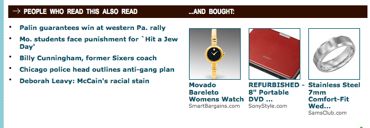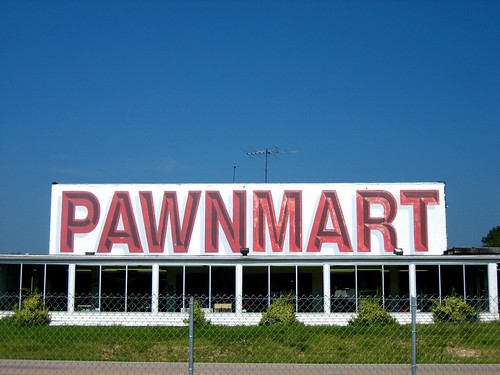Dodge City, Kansas. Caption: “I thought this was one of the funniest signs I’d ever seen. I love the fact he’s delivering a flying kick to a tornado.”
Agreed. And I see Vintage Roadside has a blog that I’d previously overlooked: vintageroadtrip.blogspot.com.
 GOODWILL HUNTING:
GOODWILL HUNTING:
Rebranding castoffs as couture — or at least as competitive with Wal-Mart.
This week in Consumed:
In the first eight months of 2008, sales at Goodwill stores in the United States and Canada increased by 7 percent over the same period last year. While that obviously runs counter to trends being reported by most retailers these days, it’s hard to say whether it counts as good news that more people are evidently buying secondhand goods. After all, many of us probably don’t think of Goodwill in terms of retail; we think of it in terms of charity.
But operators of some Goodwill stores have been making efforts to prod us to think a little differently, or perhaps more expansively, about the brand — and quite possibly the present economic gloom has primed us to be more open to that idea….
Read the column in the November 2, 2008, issue of The New York Times Magazine, or here.
Consumed archive is here, and FAQ is here. The Times’ Consumed RSS feed is here. Consumed Facebook page is here.
To make a point about Consumed that you think readers of The Times Magazine would be interested in: “Letters should be addressed to Letters to the Editor, Magazine, The New York Times, 620 Eighth Avenue, 6th Floor, New York, N.Y. 10018. The e-mail address is magazine@nytimes.com. All letters should include the writer’s name, address and daytime telephone number. We are unable to acknowledge or return unpublished letters. Letters may be edited for length and clarity.”
As mentioned in the comments to this earlier post*, I reviewed The Numerati by Stephen Baker. That review is out, in tomorrow’s NYT Book Review section — first review I’ve done for them in years, though I used to write for them a lot. Anyway, it starts like this:
Maybe you’re the kind of person who doesn’t believe that the kind of person you are can be deduced by an algorithm and expressed through shorthand categorizations like “urban youth” or “hearth keeper.” Maybe I’d agree with you, and maybe we’re right. But the kind of people — “crack mathematicians, computer scientists and engineers” — whom Stephen Baker writes about in “The Numerati” clearly see things differently. In fact, they probably regard such skepticism as more fodder for the math-driven identity formulas they’ve created to satisfy the consumer-product companies and politicians who hire them….
Here’s the link.
[* Note: The review was already written and filed prior to that post, if that matters to you at all.]
So if you’ll allow me one moment of shameless patriotism, I’d like take a moment to declare that I am a proud American.
I’ve been thinking about this because of Joe The Plumber. Forget all the foolishness about his book deal or potential endorsement contracts or whether he’ll run for congress. There’s an argument, or an idea, that always hovers around Joe and his ilk — and his ilk’s intellectual defenders in the intellectual and pundit classes — that’s always puzzled me:
Why are these people so cynical about Americans?
Let me explain what I mean. Please continue…
Speaking of oil … I just read the phrase “drill, baby, drill” for the millionth time, and it finally occurred to me to stop and think from whence this pro-oil chant is derived.
That would be, if I’m not mistaken, “burn, baby, burn,” a phrase associated with the 1960s riots. According to BlogCritics Magazine (about which I actually know nothing, it’s just the first useful thing that Google took me to), a 1965 Newsweek article about the Watts riots included “one of the first” print references to that phrase. BlogCritics continues:
Made infamous by the riots, [the phrase] was first used by a disc jockey known as Magnificent Montague when he was working in New York and Chicago in ’63 and ’64. He’s shout it any time a piece of soul music got him excited, and he brought it with him to Los Angeles where his listeners appropriated it for the arson that marked the riots. During those terrible days, his station manager and even Mayor Yorty asked Magnificent Montague to give up his slogan. He did, at least while the fires were hot, changing to: “Have Mercy, Los Angeles!”
At first I thought, well, obviously the people chanting “Drill, baby, drill” don’t know or aren’t thinking about the phrase they are referencing.
But another possibility occurs to me. It’s obviously a fantasy that America’s much-discussed “dependence on foreign oil” is something that can be significantly changed by domestic drilling, no matter what deregulation occurs. But maybe the chanters know that — and are invoking the rioters of the 1960s intentionally.
That is, maybe they simply believe in the power of destructive spectacle: If we burn it all down or in this case drill it all to nothing, then somehow, from the ashes, from the ruins, a productive revolution of some kind emerges at some unspecified time in the future. Or if it doesn’t, at least some kind of pent-up emotion, or rage, has been released and spent. And when that catharsis is complete, we can sift through wreckage and the ashes and the spent remains, and start over.
If so, I can only say quote the Magnificent Montague: “Have mercy.”
“Driving on Interstate 44 from Springfield to St. Louis Missouri is pretty boring. But then you pass by this amazing building with the most fascinating type ever and it just makes your day.”
onpaperwings has some great sets, like this one of vernacular typography Polaroids, and this one of hand dryers(!). Probably they were both on BoingBoing a year ago, but I don’t care. If you haven’t seen them, check them out. (And Tom H. if you’re out there take note of this guy.)
Some brief follow-up material about the price of oil, consumer behavior, and energy alternatives. (Earlier mention here.)
Steven Mufson of the Washington Post wrote about the issue on October 20, and more recently talked it over with public radio show Word of Mouth.
And, on Marketplace yesterday:
Already, U.S. pickup demand is back on the rise, after collapsing earlier this year. Their sales share is nearly what it was before oil prices hit their high-end tipping point. [GM research executive Tom] Kloza says, so much for the buyers being changed forever.
Similar themes all around: The fear that weak oil prices, leading to cheap gas, can end up meaning that innovation-searching slows down, because consumer demand (and thus the profit motive) aren’t sufficient.
I wouldn’t say we’ve actually hit that point. Actually in some ways the number of stories on this proves we aren’t.
But what I want to add here is that I kind of think this GM guy gets off the hook a little too easily: If GM believes it’s important to sell smaller vehicles with better mileage, then make them and sell them. It’s disappointing if it’s true that consumer behavior change on this is so easily susceptible to backsliding, but whatever. Toyota didn’t need $100-a-barrel oil to develop the Prius.
Maybe this is old news, but I didn’t know until Charles told me:
Fred Radkte, the “Gray Ghost,” the guy in New Orleans who rollers over and obliterates any and all graffiti/street art, and has even been tweaked by Banksy, got arrested.
Apparently he painted over a mural that had every right to be there. Doug MacCash in Times Picayune:
On Wednesday, Radtke, New Orleans’ most celebrated and scorned anti-graffiti activist, was in the process of rolling gray enamel over a newly finished painting when he was brought up short by a pair of National Guard Military Police officers. Though Radtke has long enjoyed the cooperation of the New Orleans Police Department, this time he had defaced art that was painted with the permission of the wall’s owner, Southern Coating and Waterproofing.
Apparently there was no comment from Radtke. But now he has something more in common with his nemeses: Like them, he’s obsessed with leaving his mark all over town, and like them, he’s been hounded by The Man! “If convicted, he could be fined up to $500 and/or spend up to 90 days in jail, plus pay restitution.”
Meanwhile the mural he went up over has been redone. Pix here.
Posted Under:
Anti,
Artists by Rob Walker on October 30, 2008
Comments Off on New Orleans top bomber: Busted!
… for best 2008 presidential election-inspired video on YouTube, is here. It’s only 2 and a half minutes, but it’s pretty great. It’s got my support.
We watched about one minute of the half-hour Obamamercial last night. It looked kind of boring, and as it happens we’ve already voted, so that was enough. In listening to and reading the rave reviews later, I was interested to hear that the total cost was, as I understand it, somewhere around $4 million or $5 million, for both production and air time on multiple networks.
I know everybody says that’s a lot of money, and for a political campaign it is. But in the larger scheme of corporate advertising, it really isn’t. Thirty seconds during the Super Bowl is more than $2 million, not counting production. More to the point, for a company like Nike, or Wal-Mart, $4 million isn’t much. Or how about Exxon Mobile: They just posted $14.8 billion in profits — for the quarter. When you’re looking at numbers like that, a few million bucks is peanuts.
I’m not arguing that, say, some oil company should take a half hour of slick propaganda time on a network near you. I’m just idly curious why it doen’t happen.
I’ve seen a few folks criticizing the redesign of the Pepsi logo, and I tend to agree: I don’t see the point, and I don’t care for the result. But PSFK has a nice image of a bunch of Pepsi cans showing the brand’s visual changes over the years, and it’s pretty cool:

The type-only versions are pretty cool, especially the very first one. But I really like the concept of putting an image of a bottle cap on the side of a can. Who thought of that? Kind of amusing. And I think the first of those two, with the elaborate and exciting type treatment, I think that’s my favorite.
See the PSFK post to view the rather bloodless new logo.
Bonus: Old Murketing post on “Be A Pepsi Punk” T-shirt in The Great Rock N Roll Swindle.
Funny story in the NYT today about a guy who has won 11 “user-generated ad” contests, “earning more than $200,000 in money and prizes.” A great example of the co-promotion theory of what inspires amateurs to make ads: It’s not about hyping the brand, it’s about hyping the maker.
Mr. Levinson has a Facebook group entitled “Yes, Joel, I’ll vote for your newest stupid contest” and he uses Twitter, blogs, e-mail and text messages, asking acquaintances to vote. He even calls 24-hour customer service lines at night, when he thinks the representatives are bored, and asks them to vote for him.
The other day I was reading some random news story on a newspaper site — I think a Philadelphia paper, and the article was something about the McCain campaign.
At the bottom was this:

I’m interested in the stuff at right. People who read this article also bought a Movado watch? Or a portable DVD player? Really? How many people? And how is that useful information?





 "
"
 GOODWILL HUNTING:
GOODWILL HUNTING:
















 Kim Fellner's book
Kim Fellner's book  A
A